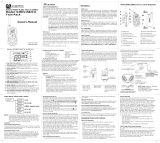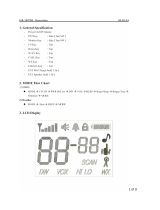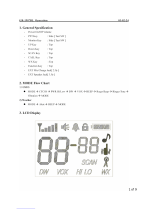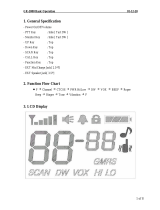Page is loading ...

General Mobile Radio Service (GMRS)General Mobile Radio Service (GMRS)
General Mobile Radio Service (GMRS)General Mobile Radio Service (GMRS)
General Mobile Radio Service (GMRS)
ModelModel
ModelModel
Model
::
::
:
GMRS122CH GMRS122CH
GMRS122CH GMRS122CH
GMRS122CH
OwnerOwner
OwnerOwner
Owner
’s Man’s Man
’s Man’s Man
’s Man
ualual
ualual
ual
© 2003 Audiovox Electronics Corp., Hauppauge, NY 11788
MODE
LOHI

NEVER ATTEMPT TO CHARGE ALKALINE OR DRY CELL BATTERIES, AS
BATTERIES MAY BURST CAUSING PERSONAL INJURY AND DAMAGE
TO THE PRODUCT. WHEN RECHARGING NICKEL METAL HYDRIDE (Ni-
MH) BATTERIES WITH THE SUPPLIED AUDIOVOX CHARGER AND WALL
ADAPTER, USE ONLY AUDIOVOX-APPROVED RECHARGEABLE BATTER-
IES. USE OF THE AUDIOVOX CHARGER WITH OTHER BRANDS OF BAT-
TERIES IS NOT RECOMMENDED, AS BATTERY CHARGING TIMES WILL
VARY WITH DIFFERENT BRANDS. REFER TO THE MANUFACTURER’S
INSTRUCTIONS FOR CHARGING OTHER BRANDS OF BATTERIES.
AVOID PLACING THE GMRS122CH RADIO TRANSCEIVER FOR PRO-
LONGED PERIODS OF TIME IN DIRECT SUNLIGHT OR TEMPERATURES
BELOW -4° F (-20° C) OR ABOVE 140 ° F (60° C).
KEEP THE ANTENNA AT 1 INCH (2.5 cm) AWAY FROM YOUR HEAD AND
BODY. DO NOT USE YOUR GMRS122CH RADIO TRANSCEIVER WITH A
DAMAGED ANTENNA.
PLACE THE RUBBER COVERS ON JACKS WHEN NOT IN USE.
GMRS LICENSE:
USE OF THIS RADIO WITHIN THE UNITED STATES REQUIRES AN FCC
GMRS LICENSE. AN INDIVIDUAL 18 YEARS OF AGE OR OLDER, WHO IS
NOT A REPRESENTATAIVE OF A FOREIGN GOVERNMENT, IS ELIGIBLE
TO APPLY FOR A GMRS SYSTEM LICENSE. YOU WILL NEED TWO FORMS
FROM THE FCC; FCC FORM 159 AND FCC FORM 605 MAIN FORM AND
SCHEDULE F. YOU CAN FIND THE FORMS ONLINE AT:
HTTP://WWW.FCC.GOV/FORMPAGE.HTML, OR CALL 1-800-418-3676.
CAUTION
2

3
1. Battery Cover
2. Monitor (M) Button
3. Detachable Carry Clip
4. Push-To-Talk (PTT) and Func-
tion Confirmation Button
5. Antenna
6. External Speaker (SP)/
Microphone (MIC)/CHG Jack
7. Built-in Speaker
Model GMRS122CH (FCC License Required)
8. Liquid Crystal Display (LCD)
9. Built-in Microphone
10. Up Channel/Volume Button
11. Down Channel/Volume
Button
12. MODE/VOX Button
13. Power On/Off and SCAN
Button
14. Battery Charging Contacts
3
5
4
1
2
12
11
13
3
(REF)
14
7
1
(REF)
10
9
6
8
MODE
PTT
M
LOHI
PTT
M

4
Model GMRS122CH DISPLAY
1. Roger Beep Tone Indicator: This icon appears when the Roger Beep
tone is on, and disapppears when the tone is not in use.
2. Transmit Indicator: Icon appears when the unit is in the transmit
mode (PTT button activated or VOX mode active).
3. Busy Indicator: This icon appears when the unit is receiving a
transmission.
4. Large Segment Display: Indicates the channel number in use between
1 and 22.
5. Scan Indicator: This function allows the user to scan a chanel every
0.5 second to search for a valid signal.
6. HI/LO Indicators: Appropriate icon appears when the transmit power
is set to desired output power.
7. Battery Level Indicator: Icon appears flashing to indicate low
battery charge level.
8. Small Segment Display: Indicates the CTCSS tone code (1-38)
function is active for the main channel in use.
9. Monitor Indicator: This function is not used.
10.Key Lock Indicator: This function is not used.
11. Voice Activated Transmission (VOX) Indicator: This function allows
hands-free conversation. The icon appears when the VOX mode is
activated.
9
10
11
7
8
1
2
4
3
5
6
LOHI

5
Equipment and Accessories Supplied
1. Radio (1) GMRS122CH
2. Owner’s Manual (1) 128-6676
3. Rechargeable Batteries (4) NiMH, P/N GMRS1222BAT
4. AC Wall Adapter GMRS1222AC
Optional Accessories
1. Boom Microphone/Headset GMRSBHST4
2. Dual Desk-Top Charger GMRS1222DS
3. Vehicle Cigarette Lighter Adapter GMRS1502CG
4. Leather Carrying Case GMRS1502LC
Powering the transceiver:
Your GMRS122CH radio transceiver operates on four AAA batteries. Alkaline
batteries will provide slightly better performance than rechargeable
batteries. Only Audiovox-approved rechargeable batteries (optional) can
be recharged in the radio transceiver using the optional desk-top charger
and associated wall adapter. This will ensure optimum performance for
the GMRS122CH. Battery charging time is typically 10-12 hours. Use of the
optional Audiovox charging equipment with other brands of rechargeable
batteries is not recommended as battery charging times will vary. Refer to
the manufacturer’s instructions for charging other brands of batteries.
Batteries
There are three methods of powering the GMRS122CH:
1. Alkaline Batteries.
WARNING: Do not attempt to recharge Alkaline batteries.
2. Audiovox Rechargeable Ni-MH Batteries - (Rechargeable Bat-
teries, Wall Adapter, Charging Stand and Cigarette Lighter
Adapter can be purchased separately).
Use only Audiovox-approved rechargeable batteries and optional
charging equipment when charging batteries internal to the unit.
NOTE: To extend battery life, avoid overcharging the batteries.

6
3. Various Brands of Rechargeable Batteries - Use of the
Audiovox charger with other brands of rechargeable batteries is not
recommended, as battery charging times will vary with different
brands of batteries. Refer to the manufacturer’s instructions for
charging other brands of batteries.
Installing the batteries:
Battery installation is made more convenient when the carry clip is either
rotated left or right to the horizontal position, or is removed. Simply rotate
the clip in either direction to the horizontal position. Be careful not to use
excessive force. To remove the clip, press down on the spring release tab
and pull the clip straight out from the radio body. Next, press down with the
thumb at the embossed arrow, slide the battery cover down and lift it away
from the compartment. Insert four AAA batteries (alternate positive ends (+)
toward the top of the transceiver, starting left-to-right.
2. Then lift cover at
bottom to open.
Remove cover.
3. Insert four AAA batteries
(positive (+) end toward
the top begining at left
side and alternating
positive terminals as
shown).
1. Using thumb,
press down on
battery cover at
arrow and slide
cover down.
CLIP SPRING
RELEASE TAB
BATTERY
COVER
CARRY
CLIP
COVER
ARROW
POSITIVE
TERMINALS
+ +
+ +

7
The following guidelines will improve performance and provide longer
operating times for the GMRS122CH:
1. Do not mix old and new batteries.
2. The use of alkaline-type batteries is recommended to provide the
longest operating time.
3. Do not mix alkaline, standard (carbon-zinc) or rechargeable
batteries.
4. If the unit is not to be used for an extended period of time, remove the
batteries. Old or leaking batteries can cause damage to the unit and
will void the warranty.
NOTE:
Only
Audiovox
approved rechargeable
batteries (P/N GMRS1222BAT)
can be recharged in the radio
transceiver.
MODE
LOHI
MIC/CHG/
SP JACK
AC WALL ADAPTER/CHARGING
TRANSFORMER MODEL: GMRS1222AC
ADAPTER
POWER
PLUG
-
+
AUDIO OX
LISTED
81J1
E81356
U
L
R
GMRS122CH
INPUT: 110VAC
OUTPUT: 7.5VDC

GMRS122CH OPERATIONAL MODES
8
NOTE: To differentiate between operating modes, look for HI or LO
indication below the battery power level indicator when in GMRS
mode.Refer to the appropriate section of this manual for de-
tailed operating instructions for each mode. Channels 1 through
7 are shared GMRS/FRS. Channels 8 through 14 are FRS only,
and channels 15 through 22 are GMRS only.
Controls:
Power On-Off/SCAN Button (13)
Press and hold the PWR on/off button for at least 2 seconds. You will hear
a confirming melody to indicate the unit is on. To turn the unit off, press and
hold the button for at least 2 seconds.
Adjusting the Volume (11, 10)
With the unit powered on, press the Up Channel/Volume button (
) to
increase volume and the Down Channel/Volume button ( ) to decrease
GMRS/FRS
(MODE)
POWER
SELECT
CTCSS
SELECT
CHANNEL
SELECT
ROGER
BEEP
(1-22)
(oF, 01-38)
(GMRS channels only)
(on or oF)

9
volume. The display will indicate the current volume level (VL) followed by
the number (0-7). As volume is increased upward, the unit will beep at
each step, and vice-versa. When the minimum and maximum volume
settings are reached, a unique tone will sound.
Monitor/Display Backlight Button (2)
This button is used to to check activity on the current frequency before
transmitting. Check activity by pressing the Monitor (M) Button longer
than 2 seconds; the
icon will apppear on the display and you will
hear static if frequency is clear.
Do not transmit if you hear conversation.
Hold down the Monitor Button again longer than 2 seconds and the
icon will disapppear from the display.
The monitor function will temporarily bypass the squelch setting and play
all signals on a given channel. This feature is useful when communicating
with other parties at extreme range.
By pressing the monitor button momentarily, the LCD backlight is turned
on; the LCD backlight will turn off automatically in about 5 seconds, unless
the monitor button is pressed momentarily once again.
Push To Talk (PTT) Button (4)
Pressing and holding this button will allow you to speak to any transceiver
that is set to the same channel and privacy code setting as yours. Hold the
transceiver approximately 1 to 2 inches from your face as you speak into
the built in microphone (9). After you have finished speaking, release the
PTT Button to allow reception of incoming signals. It is not possible to
transmit and receive at the same time. Whenever the button is pressed,
the transmit signal icon (
) will appear in the upper left corner of the
display. Releasing the button allows the unit to revert to standby mode.
When receiving an incoming signal, the
icon will appear.
The PTT Button can also be used as a two-way call ringer. Pressing the
button twice quickly will call another party on the same channel. The transmit
icon (
) will be displayed for 3 seconds and then disappear.

10
Up Channel/Volume Button (10)
In the standby mode, pressing this button will increment the listening
volume. When in function edit mode this button will be used to adjust the
unit’s settings.
Down Channel/Volume Button (11)
In the standby mode, pressing this button will decrement the listening
volume. When in function edit mode this button will be used to adjust the
unit’s settings.
MODE Button (12)
This button is used to select various feature settings in the GMRS and FRS
modes.
External Speaker (SPK)/ Microphone (MIC)/CHG Jack (6)
This jack accepts both the optional Audiovox headset/microphone connector
and the supplied wall charging adapter. For additional optional equipment
and accessories for the GMRS122CH, visit the Audiovox web site at
www.audiovox.com.
Scan Button (13)
With the unit in standby mode, press the Power On/Off Button momentarily
to enable or disable the scan function; SCAN will appear on the display.

11
Operating Modes and Features
GRMS/FRS Operation:
- Press and hold the Power On/Off button for 2 seconds to turn on
power.
- Press the MODE button so the Channel number flashes.
- Select the desired channel with the Up (10) and Down (11) Buttons.
When receiving a call, the
icon appears to indicate an incoming
call.
- Press and hold the PTT button (4) to transmit, then speak into the
microphone clearly and slowly. The Transmit icon (
) appears
on the display while the button is pressed.
- Release PTT Button (4) to receive.
- Communication can only be accomplished when the channel and
CTCSS tone frequency of at least two parties are the same.
- The CTCSS subcode (01-38) will be displayed on the LCD panel if the
CTCSS tone frequency function is enabled (not oF).
Channel Selection
In order to communicate with other GMRS/FRS units, both the transmit-
ting and receiving party must be on the same frequency.
The GMRS122CH has 22 channels (frequencies) indicated by the large
digits on the LCD display panel. Channels 1 through 7 are the shared
GMRS/FRS channels. Channels 8-14 are FRS only channels, while chan-
nels 15-22 are assigned GMRS only channels. If an FRS only channel (8-
14) has been selected, the HI or LO icon will not be displayed on the LCD
panel; otherwise, for channels 1-7 (GMRS/FRS) and 15-22 (GMRS only)
the HI or LO icon will be displayed. Communication with Audiovox GMRS/
FRS and compatible units is possible on these 22 channels. Before trans-
mitting on the selected channel, press the Monitor (M) Button (2) to check
the activity on that channel. If there is activity on the selected channel,
change to another channel that is clear.

12
To change the channel:
- From GMRS/FRS standby mode, press the MODE button (12) once
the channel number flashes.
- Press the Up Button (10) briefly to move to the next higher main chan-
nel number.
- Press the Down Button (11) briefly to move to the next lower main
channel number.
- Press the PTT button momentarily to confirm selection.
CTCSS Mode (Sub-Channel) Selection
The Coded Tone Controlled Squelch System (CTCSS) has 38 Sub-Frequencies.
This feature allows you to utilize the coded squelch tones (01-38) within a
main channel and enables you to communicate with another party on the
same main channel using the same subcode. (This filters out unwanted
transmissions from the same main channel). Since there are 38 CTCSS
Sub-channels for each main channel, a different subcode may be se-
lected for each of the 22 channels.
To change the CTCSS Sub-channel:
- From GMRS/FRS standby mode, press the MODE Button twice; a flash
ing oF or sub-channel number is displayed.
- Press the Up or Down button to select the desired sub-channel for
use (01-38 ).
- Press the PTT button to confirm selection.
The CTCSS mode can be turned off by selecting the oF icon as the setting.
NOTE: To communicate with other GMRS/FRS units, they must be
switched to the same channel and CTCSS subcode. To commu-
nicate with other GMRS units that do not have subcodes, switch
your unit to the same channel with the subcode set to oF.
The CTCSS subcodes do not prevent others from hearing your
transmission. This will only allow you to ignore all traffic on a
given channel not using the same subcode.

13
Transmit Power Selection Mode (GMRS Channels Only)
This feature permits selection of the transmitting power level to high
or low when using channels 1-7 and 15-22. Using low power, the unit
will have a lower transmit range, but battery life will be increased.
NOTE: You will find that for the majority of your needs, the low-power
setting will provide adequate communications on all channels;
there should seldom be any need to use high power, except in
situations where you need absolute maximum range. Using low
power will greatly extend battery life. We suggest you experi-
ment with switching between low and high power.
To access the transmitter power selection function:
- From GMRS standby mode, press the MODE Button 3 times until the
Po indication appears flashing on the display with a steady Hi or Lo
indication.
- Press the Up or Down button to toggle between the Hi and Lo se-
lections.
- Press the PTT button to confirm selection.
The display will indicate the current setting in standby mode.
Roger Beep Tone
The Roger Beep is a tone which is automatically transmitted whenever the
PTT button is released and the tone is enabled. This tone alerts the
receiving party that the transmission has been terminated intentionally.

14
To enable and disable the Roger Beep tone:
- From GMRS/FRS standby mode, press the MODE Button 4 times (in
FRS mode, 3 times) until the flashing Roger Beep icon (
) appears
with On or oF.
- Press the Up or Down Button to select the tone on or off as desired.
- When enabled, the tone icon (
) appears steady on the display.
- Press the PTT button momentarily to confirm selection.
VOX Selection Mode
This option enables you to have hands-free conversation. When using the
internal microphone/speaker or external microphone/headset (purchased
separately), your voice or the signal is detected and the radio transmits
and receives automatically. Your voice or nearby sound is detected and
the radio transmits without the need to press the PTT button.
To set the radio for VOX operation:
- From GMRS/FRS standby mode, press and hold the MODE button
for 3 seconds, or until the VOX icon appears on the display.
- To terminate VOX operation, press and hold the MODE button for at
least 3 seconds; the VOX indication will disappear.
Button Beep (Key Tone)
This feature allows the transceiver to sound a confirmation tone whenever
the following keys are pressed: Power On/Off/SCAN Button, Up/Down But-
tons and MODE Button. This feature is always on.
Call Ringer Selection Mode
The transceiver provides a transmit call ring melody at the receiving unit to
alert you to an incoming call.
To activate the call ringer melody:
- From GMRS/FRS standby mode, press the PTT button twice in quick
succession; a call ring melody will sound at the receiving unit to alert
the user to an incoming transmission, provided that unit is equipped
with this capability and set to the same channel.

15
Channel Scan Operation
This feature allows you to monitor all channels automatically for valid
signals. While scanning, you can transmit and receive. When a signal is
received, the scan is interrupted and will return to scan mode approxi-
mately 5 seconds after reception is terminated.
NOTE: While the SCAN mode is active, the MODE button is inopera-
tive. In addition, the scan mode will reduce the overall battery life
since the battery save function is overridden.
To enable the channel scan mode:
- From GMRS/FRS standby mode, momentarily press the Power On/Off
Button; SCAN will appear on the LCD display.
- The radio will automatically display each channel (1-22) in ascending
order to find an active main channel.
- When the unit doesn’t find any signals and you want to transmit, press
the PTT Button to return to primary channel operation. The transceiver
will automatically resume scanning approximately 15 seconds after
the communication is completed.
- If there is no activity and you want to leave the scan mode, press the
Power On/Off button momentarily and the unit will return to normal op
eration; the SCAN icon will disappear from the LCD display.

16
Battery Alert
When the battery icon ( ) blinks steadily on the LCD panel, recharge
the unit or install fresh batteries.
NOTES FOR GOOD COMMUNICATION
1 . The GMRS122CH 22 channels are shared on a ‘take turns’ basis.
This means other groups may be talking on any of the channels.
A common code of ethics/courtesy is to switch to another vacant
channel and not to attempt to talk over someone who is already using
the channel you first selected.
2. The GMRS122CH has been designed to maximize performance
and improve transmission range in the field. To avoid interference,
it is recommended that you do not use the units closer than 5 feet
apart.
3. For best transmission results, always keep your mouth about 2-3
inches from the microphone (9) and speak slowly in a normal voice.
4. To increase battery life, use the SCAN feature sparingly. This
feature will reduce operating time considerably.
Warning
•
Do not operate the transceiver unless you are licensed to do so.
•
Remove the batteries from the transceiver if it is not expected to be used
for long periods. This will eliminate the possibility of chemicals leaking
from the batteries and corroding the transceiver.
•
Avoid exposing the transceiver to water or extremes of temperature.
•
Do not use this device in or near a mining facility, which uses remotely
triggered explosives or in areas labeled “Blasting Area”. Premature or
accidental detonation may result.

•
Do not attempt to modify or in any way increase the output of this
transceiver. Its output is designed to meet the legal limits set by the FCC.
•
Do not use this device or change its batteries in potentially explosive
atmospheres as sparks in such areas could result in an explosion.
•
Turn your transceiver off wherever posted notices restrict the use of radios
or cellular telephones. Facilities such as hospitals may use equipment
that is sensitive to RF energy.
•
Turn your transceiver off on board aircraft when requested to do so.
•
Do not place your radio in front of a vehicle’s air-bag. If the air-bag
deploys, it could propel the transceiver like a projectile causing bodily
injury.
17

Troubleshooting
18
Weak or no Weak batteries Charge or replace batteries
signal received Channel and privacy Adjust the transceiver’s
code not set the same settings to match those
as target transceiver settings of the target
transceiver
Volume level too low Increase volume level
PTT Button inadvertently Release PTT Button
depressed
Excessive radio interference Change to a different
on a particular channel channel
Obstruction of radio signal Avoid operating in or near
large buildings or vehicles
Unit beeps, but Batteries extremely Charge or replace batteries
will not function discharged
when turned on
Reception of CTCSS privacy mode Turn on the CTCSS privacy
unwanted signals not on mode and set code number to
match the setting of the
target transceiver.
Interference from Turn the devices off or move
electronic devices such farther away from them.
as computers or TVs
Problem Possible cause Correction
No transmission Weak batteries Charge or replace batteries
while pressing Incorrect battery polarity Install the batteries
the PTT Button following the directions in
paragraph Installing the
Batteries.

GeneralGeneral
GeneralGeneral
General
Frequency Range:
Channels 1 through 7 are
shared with FRS radios. Refer to frequency chart on next page.
Channels 8 through 14 are
FRS only. Refer to frequency chart on next page.
Channels 15 through 22 are
GMRS only. Refer to frequency chart on next page.
Channel Spacing 12.5kHz
Privacy Codes 38 for each main channel
Dimensions (W x H x D) 2.25” W x 3.68” H x 1.125” D
(Without Antenna) (56.0 mm x 93.7 mm x 28.5 mm)
Power SupplyPower Supply
Power SupplyPower Supply
Power Supply
Power Source Alkaline Batteries, AAA (4), 6 VDC
Ni-MH rechargeable, AAA (4),
4.8 VDC, 650 mAh
Operating Time 30 hours Low Power
(Transmit: Receive: Standby) 14 hours High Power
(5: 5: 90 ratio)
(Based on alkaline batteries)
ReceiverReceiver
ReceiverReceiver
Receiver
Useable Sensitivity >-119 dBm
Maximum Audio Output Power > 0.3 Watt maximum (8 Ohm )
Modulation Distortion < 5% (1 kHz 70%)
TT
TT
T
rr
rr
r
ansmitteransmitter
ansmitteransmitter
ansmitter
RF Output Power 1.8 Watts maximum (high power)
0.5 Watt maximum (low power)
Maximum Deviation +/- 2.5 kHz
Modulation Distortion < 5% (1 kHz 70%)
19
TT
TT
T
ecec
ecec
ec
hnical Specifhnical Specif
hnical Specifhnical Specif
hnical Specif
icaica
icaica
ica
tions:tions:
tions:tions:
tions:

20
NOTE: Channels 1 through 7 are shared with FRS radios.
Channels 8 through 14 are FRS only.
Channels 15 through 22 are GMRS only.
This transceiver complies with FCC regulations for use in the United
States of America. Use in other countries may be prohibited or restricted
by local regulation. Please check with the local regulating agency be-
fore using this device outside the United States of America.
Main Channel Frequencies:
EPYT/LENNAHC)zHM(QERFEPYT/LENNAHC)zHM(QERF
SRF/SRMG15265.264SRF215266.764
SRF/SRMG25785.264SRF315786.764
SRF/SRMG35216.264SRF415217.764
SRF/SRMG45736.264SRMG510055.264
SRF/SRMG55266.264SRMG610575.264
SRF/SRMG65786.264SRMG710006.264
SRF/SRMG75217.264SRMG810526.264
SRF85265.764SRMG910056.264
SRF95785.764SRMG020576.264
SRF015216.764SRMG120007.264
SRF115736.764SRMG220527.264
/



